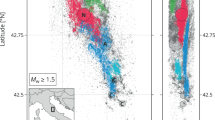Abstract
Self-similarity of the earthquake process is consistent with the observed linear b-value relation log (N) = a – bM, where N is the number of earthquakes with magnitude M. Deviations from linearity are believed to be due to statistical fluctuations because of the scarcity of events at large M, or from incompleteness because of a detection threshold at small M. Above some magnitude level, all local events are detected, because they exceed the noise background on the seismogram. As magnitude decreases, however, events go undetected as the seismic signal approaches the noise background. Thus more of the smallest events should be logged at night than during the day, because the cultural noise sources and winds are diminished at night, resulting in presumably quieter seismograms. Here we use this day-to-night noise modulation to develop a completeness test for earthquake catalogues; catalogues that indicate no significant modulation are considered complete. We test three catalogues and show that the completeness magnitude can be different from the magnitude at which the b-value departs from linearity. In particular, catalogues that show significant deviations in linearity at small M but are otherwise complete, are at odds with the hypothesis of earthquake self-similarity.
This is a preview of subscription content, access via your institution
Access options
Subscribe to this journal
Receive 51 print issues and online access
$199.00 per year
only $3.90 per issue
Buy this article
- Purchase on Springer Link
- Instant access to full article PDF
Prices may be subject to local taxes which are calculated during checkout
Similar content being viewed by others
References
Schuster, A. Proc. R. Soc. Lond. 61, 455–465 (1897).
Gardner, J. K. & Knopoff, L. Bull. seismol. Soc. Am. 64, 1363–1367 (1974).
Young, D. & Zürn, W. J. Geophys. 45, 171–182 (1979).
McNutt, S. R. & Beavan, R. J. Nature 294, 615–618 (1981).
Melchior, P. The Tides and the Planet Earth (Pergamon, Oxford, 1978).
Taylor, D. thesis, Virginia Polytechnic Inst., Blacksburg, Virginia (1988).
Taylor, D., Snoke, J. A., Sacks, I. S. & Takanami, T. Seismol. Res. Lett. 58, 105 (1987).
Author information
Authors and Affiliations
Rights and permissions
About this article
Cite this article
Rydelek, P., Sacks, I. Testing the completeness of earthquake catalogues and the hypothesis of self-similarity. Nature 337, 251–253 (1989). https://doi.org/10.1038/337251a0
Received:
Accepted:
Issue Date:
DOI: https://doi.org/10.1038/337251a0
This article is cited by
-
b value enlightens different rheological behaviour in Campi Flegrei caldera
Communications Earth & Environment (2024)
-
The 2022–2023 seismic sequence onshore South Evia, central Greece: evidence for activation of a left-lateral strike-slip fault and regional triggering of seismicity
Journal of Seismology (2024)
-
Seismic hazard assessment and site-specific response spectrum at bed rock level for Ongole city, India: a deterministic framework
Environmental Earth Sciences (2024)
-
Seismic magnitude homogenization by unified regression method and its effect on seismicity parameters
Journal of Seismology (2024)
-
Probabilistic seismic hazard assessment framework for Uganda: a stochastic event-based modelling approach
Bulletin of Earthquake Engineering (2024)
Comments
By submitting a comment you agree to abide by our Terms and Community Guidelines. If you find something abusive or that does not comply with our terms or guidelines please flag it as inappropriate.



